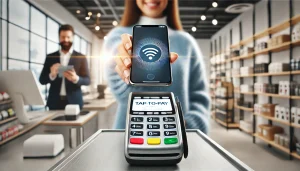Contactless payment is revolutionizing the way people in the United States manage transactions, offering a seamless and secure method of purchasing goods and services. As this technology continues to grow in popularity, understanding its intricacies becomes essential. Once considered a novelty, contactless payment systems have rapidly evolved, driven by the need for quick and convenient payment solutions.
Anúncios
The rise in contactless payments across the U.S. can be attributed to several factors. Consumers are drawn to the convenience of tapping a card or smartphone at checkout, which significantly reduces transaction times.
Additionally, the COVID-19 pandemic acted as a catalyst, encouraging populations to seek payment methods that minimize physical contact. This method of payment not only facilitates social distancing but also aligns with modern consumer habits that prioritize efficiency and safety.
Understanding the mechanics of contactless payments

At the core of contactless payment systems lie two essential technologies: NFC (Near Field Communication) and RFID (Radio Frequency Identification). These technologies enable communication between a card or device and a reader without physical contact, allowing transactions to be completed in seconds. Understanding the difference between these technologies is key to comprehending how contactless transactions work.
Contactless payments come in many forms, including contactless cards, digital wallets like Apple Pay and Google Pay, and wearable devices equipped with payment capabilities. Each option offers convenience tailored to different consumer preferences. Whether you’re tapping a card or using your smartwatch, these methods cater to a variety of user needs, seamlessly integrating into everyday transactions and making purchases faster and simpler.
Security is a significant concern for users adopting contactless payments. Thankfully, these systems incorporate robust security measures, including tokenization and encryption, to protect user data. Payment authentication processes such as biometric verification add an additional layer of security, ensuring that your transactions remain safe.
The consumer impact of contactless technology
The emergence of contactless payments has transformed consumer habits by offering unprecedented ease in making purchases. Shoppers appreciate the quick turnaround, enabling them to conduct transactions with a simple tap, thus streamlining the checkout process. This convenience has led to an increase in customer satisfaction and has shaped how consumers approach purchasing in today’s fast-paced world.
With the integration of contactless payments, the average consumer tends to spend more due to the streamlined nature of the transaction. The convenience of not having to fumble with cash or enter a PIN has encouraged more spontaneous purchases, thus increasing the average spend per visit. Retailers have noticed a trend towards higher sales, prompting them to further integrate such technologies into their systems to better meet consumer demands.
As businesses are increasingly adopting contactless solutions, they are innovating to enhance customer experience and drive sales. Retailers across the U.S. are upgrading their point-of-sale systems to accommodate these payments, ensuring they meet consumer expectations. This proactive adaptation ensures that businesses remain relevant and competitive in a market increasingly dominated by tech-savvy shoppers seeking convenience and speed.
Ensuring the safety of contactless payments
Despite the convenience offered by contactless payments, there are concerns about their vulnerability to fraud. It’s essential to dispel myths and understand the realities of these systems. Contactless payments are generally secure due to sophisticated security protocols such as encryption and tokenization that protect transaction data.
Financial institutions and card issuers have implemented various security measures to safeguard users against potential threats. These include real-time monitoring for suspicious activities and multi-factor authentication, which enhance the security features of contactless payment systems. As a result, the threat of fraud remains low, and consumers can use these technologies without undue worry.
Consumers can also take steps to protect themselves while using contactless payments. Simple actions, such as regularly monitoring bank statements, setting up transaction alerts, and using secure passwords, can help maintain the security of their accounts. By staying vigilant and leveraging the security features offered by banks and card issuers, users can confidently enjoy the benefits of contactless payment systems.
The future of contactless payment technologies
The future of contactless payment lies in its continuous evolution and integration with emerging digital commerce trends. As the digital economy grows, businesses are increasingly adopting contactless solutions to align with consumer preferences for streamlined yet secure shopping experiences.
This aligns with a broader shift towards a cashless society, underlining the potential for contactless payments to become even more prevalent. Innovations such as biometric payments, which utilize fingerprints or facial recognition, and advanced encryption technologies are set to further revolutionize the landscape of contactless payments.
These technologies promise to enhance security and user experience, ensuring transactions remain swift while maintaining high security standards. Additionally, the integration of artificial intelligence and blockchain technology holds promise for further innovations within the contactless payment sector.
AI can optimize payment processes while blockchain provides transparent and tamper-proof transaction records. These technologies, combined with the growing use of contactless methods, indicate a future where financial transactions are more seamless, secure, and efficient, reshaping how commerce is conducted globally.
In conclusion, contactless payments offer numerous advantages, from enhanced convenience and speed to robust security features that protect against fraud. While challenges exist, the potential benefits of adopting this technology far outweigh the drawbacks.






